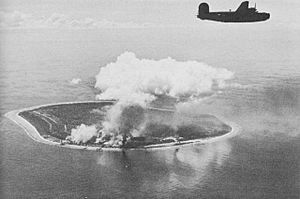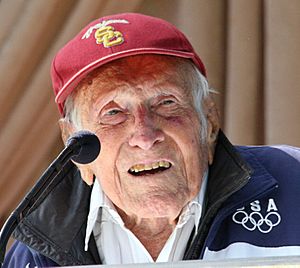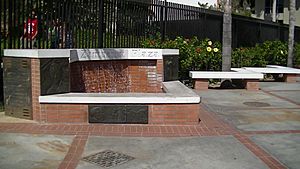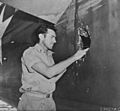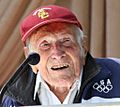Louis Zamperini facts for kids
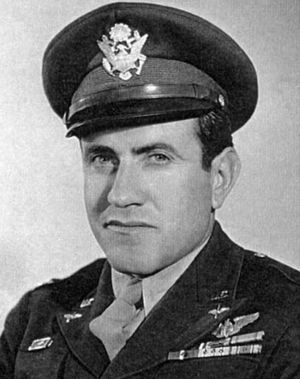
Zamperini in 1943
|
|||||||||||
| Personal information | |||||||||||
|---|---|---|---|---|---|---|---|---|---|---|---|
| Birth name | Louis Silvie Zamperini | ||||||||||
| Nickname(s) | The Zamp, Louie | ||||||||||
| Born | January 26, 1917 Olean, New York, U.S. |
||||||||||
| Died | July 2, 2014 (aged 97) Los Angeles, California, U.S. |
||||||||||
| Alma mater | USC | ||||||||||
| Height | 5 feet 10 inches (178 cm) | ||||||||||
| Weight | 132 pounds (60 kg) | ||||||||||
| Spouse(s) |
Cynthia Applewhite
(m. 1946; died 2001) |
||||||||||
| Sport | |||||||||||
| Country | United States | ||||||||||
| Sport | Track and field | ||||||||||
| Event(s) | Middle-distance running | ||||||||||
| College team | University of Southern California | ||||||||||
| Achievements and titles | |||||||||||
| Olympic finals | 1936 Berlin: 5000 m – 8th | ||||||||||
| Personal best(s) |
|
||||||||||
Louis Silvie Zamperini (January 26, 1917 – July 2, 2014) was an amazing American who lived a remarkable life. He was an Olympic runner, a brave soldier in World War II, and later, someone who helped others through his Christian faith.
Louis started running in high school. He became so good that he qualified for the 1936 Berlin Olympics in the 5,000-meter race. He finished 8th, but he ran his final lap faster than anyone else!
During World War II, Louis became a bombardier in the United States Army Air Forces. His plane crashed into the ocean during a search mission. He survived for 47 days on a life raft with two other crewmates. They faced many dangers, including sharks and a Japanese plane attacking them.
After reaching land, Louis was captured by the Japanese. He was held in several prisoner-of-war camps where he was treated very badly. One guard, Mutsuhiro Watanabe, was especially cruel to him. Louis was finally set free when the war ended.
After the war, Louis struggled with what he had been through. But he found peace through his Christian faith. He became a speaker, sharing his story of forgiveness. He also worked to help young people who were struggling. Louis's life story has been told in three movies, including Unbroken.
Contents
Louis Zamperini's Early Life
Louis Zamperini was born on January 26, 1917, in Olean, New York. His parents, Anthony and Louise, were from Verona, Italy. Louis had an older brother, Pete, and two younger sisters, Virginia and Sylvia. His family was very religious.
When Louis was two, his family moved to Long Beach, California. In 1919, they moved to Torrance. Louis and his family didn't speak English at first, which made him a target for bullies. His father taught him how to box to defend himself. Louis became good at fighting, but it often got him into trouble.
High School Running Star
To help Louis stay out of trouble, his older brother Pete encouraged him to join the school track team. Pete was already a star runner. Louis had tried running before and came in last, which made him feel embarrassed. But Pete helped him train.
Louis started winning races and getting much faster. He looked up to another runner, Glenn Cunningham. Louis became a distance runner. By the end of his first year, he was already finishing well in races.
After a summer of training in 1932, Louis became unbeatable in high school. He even broke his brother's running records. In 1934, he set a new record for the mile at 4 minutes, 21.2 seconds. This amazing achievement helped him get a scholarship to the University of Southern California.
Qualifying for the Olympics
In 1936, Louis decided to try for the Olympics. Back then, athletes had to pay to go to the Olympic trials. But Louis's father worked for the railroad, so Louis got a free train ticket. People in Torrance also raised money to help him.
The competition for the 1,500-meter race was very tough that year. So, Louis decided to run the 5,000-meter race instead. It was one of the hottest days of the year in New York. Many runners struggled in the heat. Louis finished in a tie with Don Lash, who held the American record. This meant Louis qualified for the 1936 Summer Olympics in Berlin, Germany. At 19 years old, he was the youngest American to qualify for the 5,000-meter race.
The 1936 Berlin Olympics
Most people didn't think Louis or Don Lash had a chance to win the 5,000-meter race at the 1936 Olympics. The world record holder, Lauri Lehtinen from Finland, was expected to win.
Louis shared some funny stories from his trip to Europe. He said he ate a lot of free food on the boat, gaining 12 pounds! This wasn't great for running, but it helped him recover from losing 15 pounds during his intense training.
In the Olympic race, Louis finished 8th with a time of 14 minutes, 46.8 seconds. Even though he didn't win, his final lap was incredibly fast, only 56 seconds! This caught the attention of Adolf Hitler, who asked to meet Louis. Louis said Hitler shook his hand and told him, "Ah, you're the boy with the fast finish."
College Running Achievements
After the Olympics, Louis went to the University of Southern California. In 1938, he set a national college record for the mile run (1609 meters) with a time of 4 minutes, 8.3 seconds. This record lasted for 15 years! He earned the nickname "Torrance Tornado" because of his speed.
Louis Zamperini's World War II Service
Louis joined the United States Army Air Force in September 1941. He became a second lieutenant and a bombardier on a Consolidated B-24 Liberator bomber named Super Man. He was stationed on the Pacific island of Funafuti.
In April 1943, Super Man went on a bombing mission against the Japanese-held island of Nauru. After the mission, three Japanese planes attacked their bomber. The plane was badly damaged, and five crew members were hurt. Louis helped give first aid to the wounded. When the plane landed, ground crew counted 500 bullet holes in it!
Lost at Sea
Because Super Man was too damaged to fly, Louis and his healthy crewmates were sent to Hawaii. Louis was then assigned to a search mission to find a lost plane and crew. They were given another B-24 bomber called Green Hornet, which was known for having problems.
On May 27, 1943, during the search, the Green Hornet had mechanical problems and crashed into the ocean. Eight of the 11 men on board died.
Louis Zamperini, pilot Russell Allen Phillips, and Francis McNamara were the only three survivors. They had very little food or water. They survived by collecting rainwater, eating small raw fish, and catching birds that landed on their raft. McNamara used an oar to fight off a shark! They tried to get the attention of a search plane, but it didn't see them.
They managed to stay afloat on two small rafts. They caught two albatrosses, ate one, and used parts of it for bait to catch more fish. They constantly had to fight off sharks. A Japanese bomber even attacked them, shooting holes in their raft, but no one was hit. After 33 days at sea, Francis McNamara died. Louis and Phillips wrapped his body and put it into the ocean.
Prisoner of War
After 47 days adrift, Louis and Phillips finally reached the Marshall Islands. They were immediately captured by the Japanese Navy. They were held as prisoners and treated very badly until the war ended in August 1945.
First, they were held at Kwajalein Atoll. After 42 days, they were moved to a Japanese prisoner-of-war camp called Ōfuna. This camp was for captives who were not officially registered as prisoners of war. After about a year in Ofuna, Louis was moved to the Ōmori POW camp in Tokyo. Finally, he was sent to the Naoetsu POW camp in northern Japan, where he stayed until the war ended.
Louis was especially tormented by a cruel prison guard named Mutsuhiro Watanabe, who was known as "The Bird." Watanabe was later listed as one of Japan's most wanted war criminals.
Louis Zamperini's Life After the War
At first, Louis was declared missing at sea. Then, a year and a day after he disappeared, the US government mistakenly said he had been killed in action. President Franklin D. Roosevelt even sent his parents a letter of sympathy. It wasn't until the war ended in late 1945 that Louis was found alive and freed. When he finally came home, he was welcomed as a hero.
Louis married Cynthia Applewhite in 1946. They had two children, Cissy and Luke. Cynthia passed away in 2001.
Finding Forgiveness
After the war, Louis struggled with the terrible things he had experienced. His wife, Cynthia, became a Christian and encouraged him to attend a meeting led by Billy Graham. In 1949, Louis went to the meeting. Graham's words reminded Louis of the prayers he had said while on the life raft and in prison. Louis decided to commit his life to Christ. After this, he was able to forgive his captors, and his bad dreams stopped.
Billy Graham later helped Louis start a new path as a Christian speaker. One of his main messages was about forgiveness. He even visited many of the guards from his POW days to tell them that he had forgiven them. In October 1950, he visited Sugamo Prison in Tokyo, where many war criminals were held, and offered them forgiveness. Louis said that some of them became Christians because of his message.
Later Years and Legacy
In January 1998, just before his 81st birthday, Louis carried the Olympic Torch for the Winter Olympics in Nagano, Japan. This was not far from where he had been held as a POW. While there, he tried to meet with Mutsuhiro Watanabe, "The Bird," his cruelest tormentor. Watanabe had avoided being punished as a war criminal. But Watanabe refused to see him. Louis sent him a letter, saying that even though he had suffered greatly, he forgave him. Louis never received a reply, and Watanabe died in 2003.
Louis continued to be active in his 90s. He often went to USC football games. He even appeared on The Tonight Show with Jay Leno in 2012, sharing stories about his life.
Louis Zamperini died from pneumonia on July 2, 2014, at his home in Los Angeles. He was 97 years old.
Books and Films About Louis Zamperini
Louis Zamperini wrote two books about his experiences, both called Devil at My Heels.
Author Laura Hillenbrand wrote a very popular book about Louis called Unbroken: A World War II Story of Survival, Resilience, and Redemption (2010). It became a #1 New York Times bestseller.
The book Unbroken was made into two movies. The first movie, Unbroken, was directed by Angelina Jolie. It starred Jack O'Connell as Louis and covered his life up to his return from the war. A sequel, Unbroken: Path to Redemption, was released in 2018. It showed Louis's recovery after being a POW and his journey of faith.
In 2015, the Billy Graham organization released a short film called Captured by Grace. This film focused on Louis's strong Christian faith, which he said helped him stay "unbroken."
Honors and Awards
Louis Zamperini received many honors and awards throughout his life.
- He was a torchbearer for the 1984 Summer Olympics in Los Angeles and the 1998 Winter Olympics in Nagano, Japan.
- Torrance Airport was renamed Zamperini Field in his honor on December 7, 1946.
- Torrance High School's football, soccer, and track stadium was named Zamperini Stadium.
- The entrance plaza at USC's track and field stadium was named Louis Zamperini Plaza in 2004.
- On May 10, 2008, he received the Ellis Island Medal of Honor.
- In October 2008, Louis was added to the National Italian American Sports Hall of Fame.
- He received honorary degrees from Azusa Pacific University and Bryant University.
- In 2011, he threw out the first pitch at a Red Sox-Cubs baseball game at Fenway Park.
- He was chosen as the Grand Marshal of the 2015 Rose Parade. After his death, his family honored him in the parade.
- In 2013, the dining hall at Kwajalein Atoll was renamed The Captain Louis S. Zamperini Dining Facility.
- In 2015, he was named the class exemplar for the United States Air Force Academy Class of 2018, recognized for his courage and character.
- In 2017, a part of the 405 Freeway in Torrance was named the Louis Zamperini Memorial Highway.
Images for kids
See also
 In Spanish: Louis Zamperini para niños
In Spanish: Louis Zamperini para niños
- Four-minute mile
- List of people who disappeared mysteriously at sea


